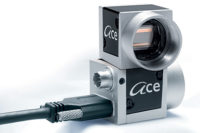Cameras are everywhere. The need for increased automation, higher quality manufacturing, and smarter machines has fueled the growth of vision being embedded into machines, robots and other systems that can use visual data to gain a more complete understanding of the environment around them. The volume of industrial cameras being embedded into systems has been shifting away from interfaces that require expensive dedicated frame grabbers to using consumer-based buses like FireWire, Ethernet, and USB, which enable vision to be added to a greater number of systems. The latest step forward in this trend is the recent release of the USB3 Vision standard.
The standard was released in January 2013 and is a new machine vision standard based off of the USB 3.0 interface. USB3 Vision has a number of benefits for industrial and embedded vision applications, especially over the USB 2.0 interface. Ten billion USB 2.0 ports exist in the world today, but the bus was never universally adopted as an industrial camera interface and while the bandwidth limitations surely decreased the potential adoption rate, one of the main reasons for the limited success of USB 2.0 in machine vision applications is the lack of a standard. If you wanted to use a specific USB camera, it means you generally had to commit to using that vendor’s SDK or API to interact with the camera or potentially find some third party software package that happened to support that particular camera.
USB3 Vision is standards-based, so no camera vendor drivers are needed to make the cameras work on third party systems. It also opens up custom development either on the camera or host side as well as embedded systems because you are no longer locked into an operating system that the vendor’s driver supports.
Standards-based camera interfaces, such as Camera Link and GigE Vision have seen a lot of success in the machine vision market and USB3 Vision should see similar results, potentially faster. USB3 Vision will unseat GigE Vision in certain applications, but the unique pros and cons of each interface will ensure that both remain popular for years to come. USB3 Vision has a higher bandwidth of 400+ MB/s but the standard only specs cables up to five meters, compared to 100 meters for GigE Vision. Active repeaters and fiber optic options can increase the cable length to be comparable to GigE Vision, but cost and system complexity then become issues. Both camera interface standards are based on the GenICam programming interfaces, which is administered by the European Machine Vision Association. With GenICam under the hood, the programming experience of the two standards is identical, which means system designers can choose the interface best suited for their application using criteria such as bandwidth and cable length without fretting over software peculiarities or nuances.
With bandwidth up to 400+ MB/s, USB3 Vision is 10x faster than USB 2.0 and can compete with many machine vision standards on speed alone. It also provides about 4.5W of power over the cable for devices and cameras, which simplifies cabling and system complexity. This has been a trending need over the past couple of years with additions to the Camera Link and GigE Vision standards to allow for powering cameras over the cables. Since they were late additions to the standards, most frame grabbers and NICs do not provide power, but USB3 Vision has it built into the specification from version 1.0. USB 3.0 was also designed to transfer data more efficiently and removed many of the inherent inefficiencies of USB 2.0, such as the need for CPU polling. USB 3.0 also uses ‘bulk’ communication, which is a common mechanism for high speed transfers and also ensures reliable data transfers. While the USB 3.0 standard was not designed with zero-copy DMA in mind, the USB3 Vision standard does implement an innovative streaming mechanism to allow zero-copy DMA, which accommodates any size image, error conditions, and variable-sized images per frame. With zero-copy DMA, cameras can directly place images into buffers that the host application controls, which further streamlines data transfer.
The normal USB 3.0 standard stems from the consumer space so there is no locking mechanism built-into the standard. While relying on the force of the connector for cable retention is acceptable in the consumer space it may not be in the industrial embedded space. Many times, cameras are connected to moving or vibrating parts and having a camera be unexpectedly disconnected can result in lost time, money, or worse. The USB3 Vision standard built on top of the normal USB 3.0 standard by including cable and connector design into the standard. The mechanical design has screw-locking connectors for the camera and host sides to allow robust, industrial-quality connections.
While USB has not been a widely adopted vision interface in the past for system designers embedded vision into a machine or device, USB3 Vision is positioned to ramp up quickly. Camera manufacturers have been highlighting their USB 3.0 offering at recent trade shows and with the new USB3 Vision standard released, the major players are on board. It was also recently announced that the USB 3.0 Promoter Group plans to double the USB 3.0 speed to 10 Gb/s in an update later this year. Given the popularity and availability of USB, USB3 Vision should prove to be a popular solution for many machine vision system designers.
TECH TIPS:
- With bandwidth up to 400+ MB/s, USB3 Vision is 10x faster than USB 2.0 and can compete with many machine vision standards on speed alone.
- It also provides about 4.5W of power over the cable for devices and cameras, which simplifies cabling and system complexity.
- This has been a trending need over the past couple of years with additions to the Camera Link and GigE Vision standards to allow for powering cameras over the cables.





